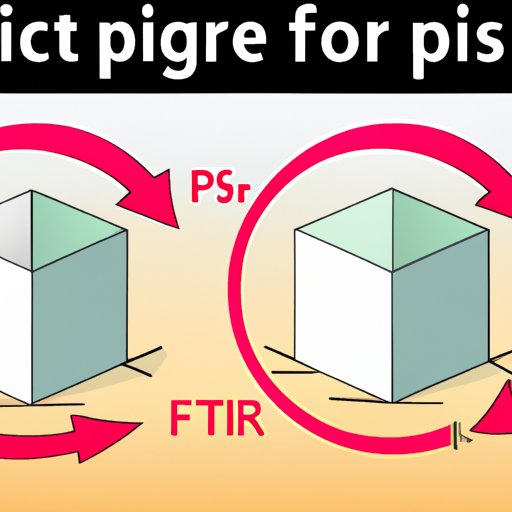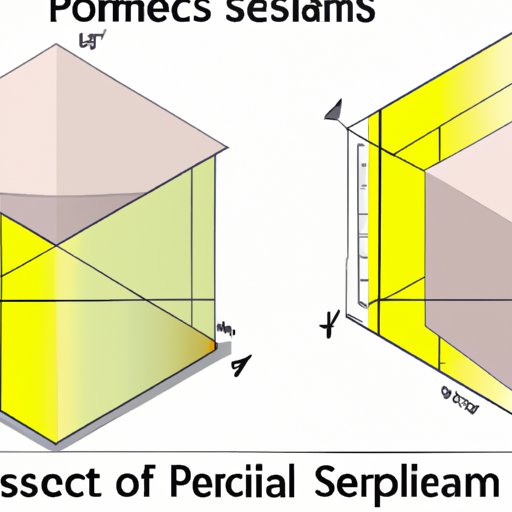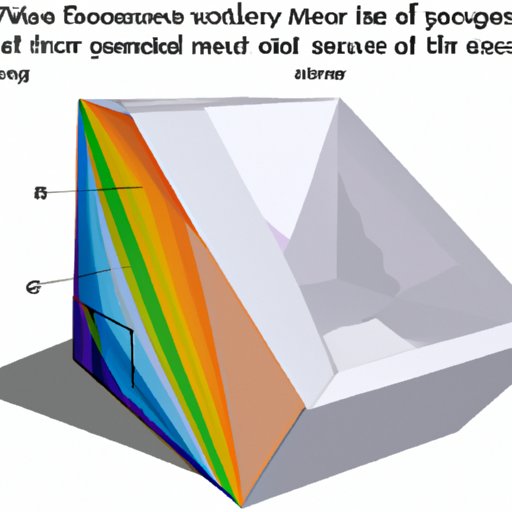Introduction
The surface area of a prism is the total area of its faces. Prisms are three-dimensional figures that have two parallel and congruent bases connected by lateral faces. The base shapes of prisms can vary, such as triangles, rectangles, or hexagons. Calculating the surface area of a prism requires understanding the base shape and dimensions and using the correct formula to determine the total area.
Step-by-Step Guide to Calculating the Surface Area of Prisms
Calculating the surface area of a prism is a multi-step process. The following steps provide an overview of how to measure the total area:
Understanding the Base Shape and Dimensions
The first step in calculating the surface area of a prism is to identify the base shape and its dimensions. For example, if the base is a rectangle, then you need to know the length and width of the rectangle. If the base is a triangle, you must know the length of all three sides. Knowing the base shape and its dimensions will allow you to use the appropriate formula for calculating the surface area.
Calculating the Lateral Surface Area
The second step in calculating the surface area of a prism is to find the lateral surface area. This is the area of the faces connecting the two bases. To do this, you must first determine the perimeter of the base shape. Then, you must multiply the perimeter by the height of the prism. This will give you the lateral surface area.
Calculating the Total Surface Area
The last step in calculating the surface area of a prism is to add the lateral surface area to the area of the two bases. This will give you the total surface area of the prism. Depending on the base shape, different formulas may be used to calculate the area of the bases.

Tips and Tricks for Finding the Surface Area of Prisms
When calculating the surface area of a prism, there are several tips and tricks that can help make the process easier. These include:
Using Calculators or Online Tools
Using a calculator or an online tool can make it easier to calculate the surface area of a prism. These tools can automatically calculate the perimeter and area of the base shape, as well as the lateral surface area. This can save time and reduce the risk of making errors.
Memorizing Formulas
Memorizing the formulas for calculating the area of the base shape and the lateral surface area can make it easier to calculate the total surface area of a prism. By committing these formulas to memory, you can quickly determine the total area without having to look up the formulas every time.
Drawing Diagrams
Drawing diagrams can help visualize the problem and make it easier to solve. Drawing a diagram of the prism can help you identify the base shape and its dimensions, as well as the lateral surface area. This can help you understand the problem more clearly and make it easier to calculate the total surface area.
A Comprehensive Overview of Measuring the Surface Area of Prisms
To fully understand how to calculate the surface area of a prism, it is important to analyze the different types of prisms and explore the different formulas used to calculate the surface area. Different types of prisms, such as triangular prisms, rectangular prisms, and hexagonal prisms, require different formulas to calculate the total surface area. Exploring the different formulas used to calculate the surface area of each type of prism can help you better understand the process of finding the total area.

Visualizing the Process of Calculating the Surface Area of Prisms
Creating a visual representation of the problem can help you better understand the process of calculating the surface area of a prism. Visualizing the problem can help you identify the geometric shapes involved and the dimensions of each shape. This can make it easier to calculate the lateral surface area and the total surface area of the prism.

Analyzing the Benefits of Knowing How to Find the Surface Area of Prisms
Knowing how to calculate the surface area of a prism can be beneficial in many ways. Knowing how to find the surface area of prisms can help you apply your knowledge to real-world problems, such as determining the amount of paint needed to paint a room with walls made of various types of prisms. Additionally, learning how to calculate the surface area of prisms can help enhance your math skills and prepare you for more advanced topics in geometry.
Conclusion
In conclusion, calculating the surface area of a prism is a multi-step process that requires understanding the base shape and dimensions, as well as the appropriate formulas for calculating the lateral surface area and the total surface area. There are several tips and tricks that can help make the process easier, such as using calculators or online tools, memorizing formulas, and drawing diagrams. Knowing how to find the surface area of prisms can be beneficial in many ways, such as applying your knowledge to real-world problems and enhancing your math skills.
(Note: Is this article not meeting your expectations? Do you have knowledge or insights to share? Unlock new opportunities and expand your reach by joining our authors team. Click Registration to join us and share your expertise with our readers.)
